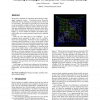Free Online Productivity Tools
i2Speak
i2Symbol
i2OCR
iTex2Img
iWeb2Print
iWeb2Shot
i2Type
iPdf2Split
iPdf2Merge
i2Bopomofo
i2Arabic
i2Style
i2Image
i2PDF
iLatex2Rtf
Sci2ools
VISUALIZATION
1999
IEEE
1999
IEEE
Rendering on a Budget: A Framework for Time-Critical Rendering
We present a technique for optimizing the rendering of highdepth complexity scenes. Prioritized-Layered Projection (PLP) does this by rendering an estimation of the visible set for each frame. The novelty in our work lies in the fact that we do not explicitly compute visible sets. Instead, our work is based on computing on demand a priority order for the polygons that maximizes the likelihood of rendering visible polygons before occluded ones for any given scene. Given a fixed budget, e.g. time or number of triangles, our rendering algorithm makes sure to render geometry respecting the computed priority. There are two main steps to our technique: (1) an occupancy-based tessellation of space; and (2) a soliditybased traversal algorithm. PLP works by first computing an occupancy-based tessellation of space, which tends to have more cells where there are more geometric primitives. In this spatial tessellation, each cell is assigned a solidity value, which is directly proportional to its ...
Occupancy-based Tessellation | Traversal Algorithm | Visible Sets | Visualization | VISUALIZATION 1999 |
| Added | 04 Aug 2010 |
| Updated | 04 Aug 2010 |
| Type | Conference |
| Year | 1999 |
| Where | VISUALIZATION |
| Authors | James T. Klosowski, Cláudio T. Silva |
Comments (0)

